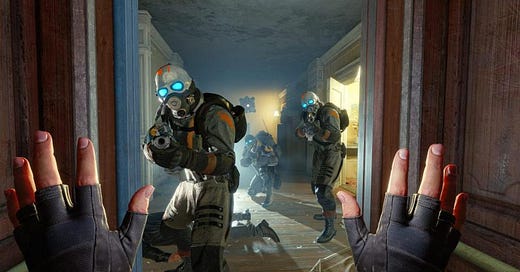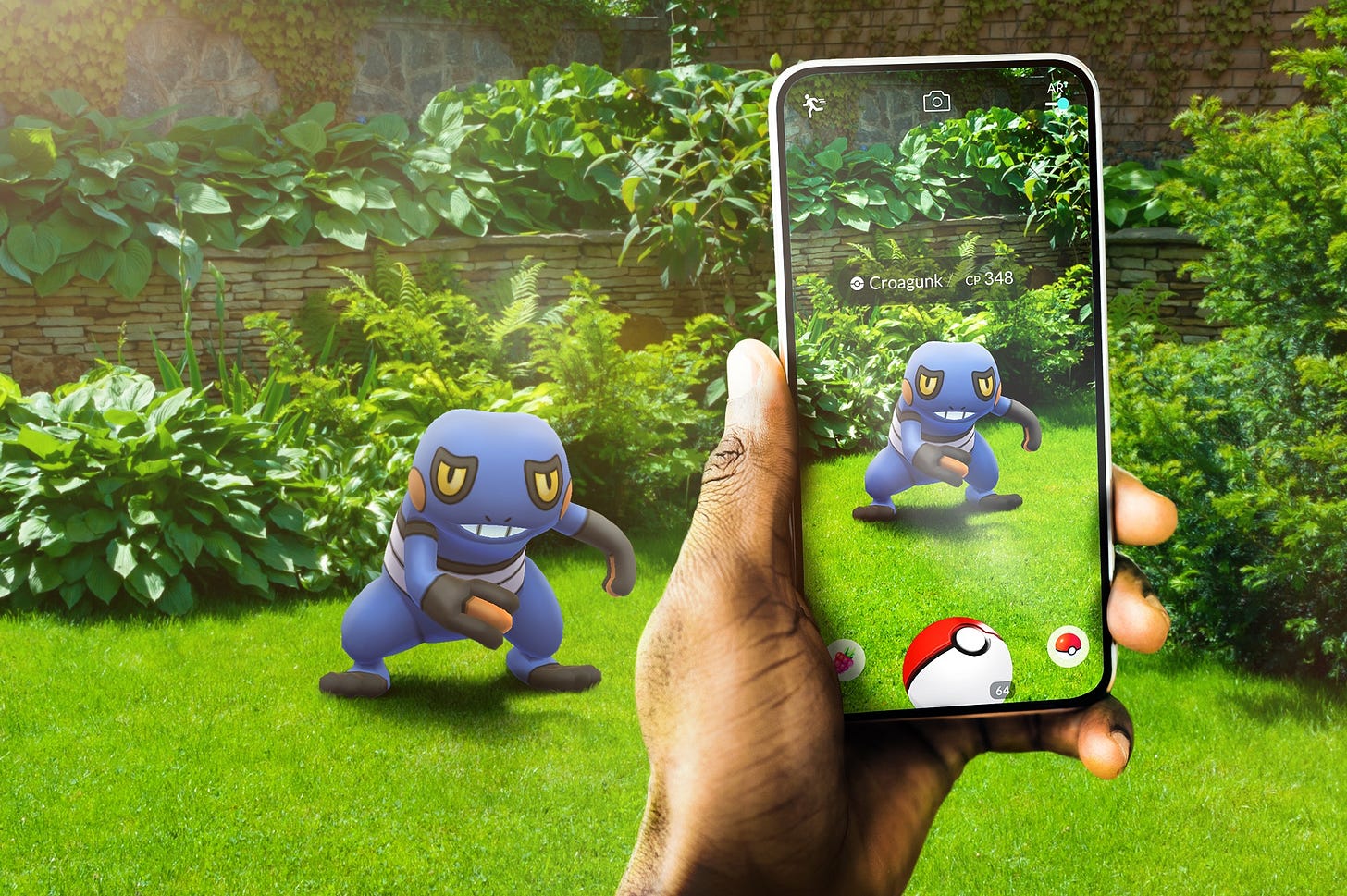Masters of Disruption: How the Gamer Generation Built the Future [28]
John Romero on the future of VR and AR gaming.
This post is part of a yearlong project I’m serializing exclusively in my newsletter, Disruptor. It’s a follow-up to my first book, Masters of Doom: How Two Guys Built an Empire and Transformed Pop Culture, and it’s called Masters of Disruption: How the Gamer Generation Built the Future. You can find the table of contents, as it unfolds, here. To follow along, please subscribe below. Thanks!
In September when I launched this newsletter, I caught up with game designer John Romero. Here’s our conversation about the future of virtual and augmented reality.
David Kushner: How do you see the future of virtual reality evolving? Where does it go 10, 20 years from now?
John Romero: VR is going to be used for so many things besides games. It's being used for healthcare right now - recovery, remote surgery, remote diagnosis. There are so many applications for VR as just another way to visualize things. VR with Oculus is really crisp and clear and it's very solid, the tracking is amazing. It offers a different experience, but also offers a much bigger view of what you're looking at when you are doing remote work. It has specific applications that will be better than looking at a monitor or even looking at your phone, just because of the size, like you have this whole, ‘I can look all over the place’ kind of view. VR is just another way of visualizing a space or visualizing a specific thing that you're trying to do. Everybody is very actively figuring it out. People want VR to work in some way. They want to know what the billions of dollars were for. It’s not going to be the solution to games. It will be the solution to a lot of other things probably, but it might just be industry that uses it versus home users.
David Kushner: Why do you think there hasn’t been a breakout game yet for VR, like the how Doom defined PC gaming.
John Romero: It'll take time. But I believe that something will happen, because the technology has gotten a very good. I remember when Canabalt came out on an iOS, and I was just pissed because it's, like, this could have been done on an Apple II in the '70s. Granted it's an amazing game, but design language had to evolve to a point where the design made sense to players, I think that we're seeing that with VR. The design language has not reached the inflection point for what VR is good for.
It's, like, how does science happen? How do we get new materials because some random accident happens and somebody mixes something with something else and you get something that no one's seen before? It’s like Minecraft, that could have been made so long ago, decades ago. But no one did it. And it's just an idea. There could have been a fast simplified implementation that could have been the glimmer of what Minecraft was when he released it. But it would have been a super powerful idea that changed the whole industry, if it had come out decades earlier, and it could have. And so design languages needed to evolve. And so I think we're still looking at how game design language is still evolving to something that we haven't reached yet, but will influx through VR to be something that everybody thinks is now the killer. This is the real reason why we have VR.
David Kushner: Which games get you the most excited about the potential of VR. Are there ones that you-
John Romero: Well, I haven't played Alyx, but I hear that that is like as close to an incredible VR experience as you're going to get for a game. So I want to play it. I have a Quest 2, I just need to install it and start playing it. But that, to me, feels like that is a direction to go in for a certain type of experience. But then it's probably going to be experiences that we haven't thought of that will happen and will prove VR to be something it was made for.
David Kushner: Beat Saber comes close.
John Romero: Yeah. They have that everywhere. Like everybody plays Beat Saber.
David Kushner: And Carmack is out there playing it with fans.
John Romero: Yeah.
David Kushner: Beat Saber is working within the constraints, it's simple, it's intuitive. You don't need to go through a training really. In that sense to me, it evokes the games that you guys did.
John Romero: You know what to do.
David Kushner: Yeah, you know what to do.
John Romero: You have to hit it. Yeah. I know. It’s funny, I have a weird association with that game with Discs of Tron.
David Kushner: What are the other innovations that you’re excited about right now
John Romero: Well, AR definitely. I feel better about AR than VR, game-wise. One of the coolest demonstrations I saw of ARKit was during Apple's keynote. They had a table, and they built a bunch of LEGO and they could use the LEGO app to look into the buildings that they created physically. They could look into it virtually and have characters in there and have fighters going and all this stuff that was happening in the virtual world shown on their phone. It was an amazing keynote. I have never seen that before in any way, but it was a really neat merging of the physical world and virtual world. You sit there and you build some really cool LEGO on a table and a certain shape. And all of a sudden, it's a game now. Now you have characters that you put inside of your virtual world and they're running around and you can pick them up and place them somewhere else. In real life, it's just a pile of LEGO that you put together on a table, but on your iPad or your phone, it's a world that's alive now. It’s so cool that they could actually scan everything that you put together and that has become a concrete piece of AR stuff.
David Kushner: Pokémon GO had people walking into the sea. Even guys with Doom didn't even achieve that: people drowning.
John Romero: [laughs] I know it's nuts, and it was not even a game company.
David Kushner: Why did that design work do you think?
John Romero: Well, Pokémon GO was interesting from a design viewpoint. For a long time, people have been trying to figure out what kind of game can you make on a mobile device that people would love to play, like random strangers. It was always ninja assassination games and location-based stealth games with other people that you don't know. It was always about doing something in the world. But when they harnessed an IP that so many people love and they just said '"here's a map, and we're going to place these things in the spawn points.” It's very simple, and an IP people love. It's collect them all, which is what Pokemon was all about. And then it's location-based where you can look at it. It was this new experience for a lot of people. Here is an AR experience with an IP that they love and, boom, go do it.
Now, it could have been executed better. The company wasn't a game company and the Pokémon GO app was not a solidly programmed app like you would see in any professional commercial mobile game. But it did what it needed to do, and people didn't really have a problem using it. It got people excited, got them outside and got them collecting the characters. That was a really big lesson in what would people do. “Would people actually do this? Would they go outside for this stuff?” And the answer is yes. The funny thing is there's a subculture of geocaching that is almost like the same thing, except it involves clues and sleuthing to figure out where the prize is. It’s not obvious the way that Pokémon GO is. I'm sure that somebody could figure out a way of making geocaching less mysterious and less hard to execute, but geocaching has been around for decades. People have been doing it for so long, but it's like, here's an open version of geocaching, go get the thing. It just spawned, and everyone's running after it.
David Kushner: Does designing a game for AR interest you?
John Romero: Well, no. Designing for AR is interesting. But running around through the city to go collect a Pokemon character doesn't interest me, because I don't care about Pokemon. And if it was a Doom character, I still wouldn't care about it because what do I get?
David Kushner: What kind of experience would you be interested in creating with AR?
John Romero: One of the things I do like about AR is the way that you can have a flat surface that shows the stuff that's on the table in front of you, but then it can superimpose graphics onto that as if it's locked down on that location. The fact that you can zoom in, it's almost to me similar to the way VR is an experience that you don't get anywhere. AR zooming is also another experience that just doesn't happen all the time. Zooming into something and looking really closely inside. If you write something specifically for AR that takes advantage of the zooming, you could do crazy stuff. I think that there's something interesting with that. It doesn't require you to go running around town.






